A suspected Revolutionary War Continental Army Cemetery in Head of Elk (Elkton),
Cecil County, Maryland
April 2019
by Daniel M. Popek (Army Brat and Author; Descendant of an enlisted soldier who served six years in Rhode Island's Continental Line)
In Association with "Friends of America's Continental Line (Revolutionary War)" Facebook Group
History Introduction
Head of Elk [now Elkton], Maryland was a strategic crossroads on the main north-south coastal route of the American eastern seaboard. In
1777, the British landed troops near Head of Elk and briefly occupied the small village on their way to capture the American capital city
of Philadelphia, Pennsylvania. After the British evacuated Philadelphia in the first half of 1778, Cecil County, Maryland remained
in American hands for the remainder of the war. In early 1781, General Lafayette commanded a detachment of hand-picked Light Infantry
soldiers from the American Grand Northern Army in the West Point, New York area [one of my ancestors was a Sergeant in the Light Infantry
Company of the Rhode Island Regiment (Continental); studying his story is how I learned several unit details]. General Lafayette's Light
Infantry Brigade passed through Head of Elk a couple of times before heading to Virginia.
In the fall of 1781, the French Army and a large detachment of American Continental soldiers marched through Cecil County to engage
Lord Cornwallis' British troops at Yorktown, Virginia. The siege at Yorktown was successful, but what many Americans don't know is that
a significant smallpox epidemic broke out amongst the American and French soldiers who served in Virginia. In November 1781, many of
the American regiments and Light Infantry detachments were ordered back to the West Point, New York area. With sickness breaking out,
a chain of military hospitals was established on the march route from Williamsburg, Virginia to Trenton, New Jersey. The following is
a brief summary of known military hospitals and the doctors that supervised the particular hospital (if known).
Williamsburg, Virginia
A flying hospital was established immediately behind the American siege lines at Yorktown, Virginia. A larger American military hospital at
Williamsburg was set up in the abandoned Governor's Palace site, which was burned down in December 1781. Doctors Malachi Treat of New York
City and James Tilton of Wilmington, Delaware supervised the medical hospitals in the Williamsburg, Virginia area. A Continental Army cemetery
was discovered by accident in the Governor's Palace gardens in the 1930s with fairly well-preserved human skeletons. After finding a manuscript
document in Rhode Island which identified the death locations of most of Rhode Island's 1781 to 1782 war dead, I was able to identify the Rhode
Island soldier buried in Grave 156 in Williamsburg because of the unique Rhode Island Regiment uniform buttons discovered in that grave and the
manuscript document. I am attempting to get a U.S. Department of Veterans Affairs monument erected for the Rhode Island soldier, but so far,
Colonial Williamsburg Management has not been cooperative. I have identified some other likely Continental soldiers buried at Williamsburg,
but their specific graves will likely not be identified because of a lack of recovered, distinct military uniform buttons.
Annapolis, Maryland
A military hospital was established at or near Annapolis, Maryland in late August 1781 at the Anne Arundel County Poor House, but I don't know
the exact location of the Poor House [any Maryland historians that know the exact location of this building in 1781, please email me below; see
"Journal and Correspondence of the Council of Maryland," Vol. 45, 1780 - 1781, p. 581]. We know from Surgeon (Doctor) Daniel Shute's Journal
that almost 50 soldiers had the smallpox at the Annapolis military hospital on November 29, 1781. Private Crippen Hurd Jr. of East Haddam,
Connecticut gave an excellent account of his suffering of illness after he served in the Yorktown, Virginia campaign: "... and sometime in
the month of March 1781 I joined the Continental Army and was anexed [sic, annexed] to Capt Caleb Baldwin's Company in Col Heman Swifts
[2nd Connecticut Continental] Regt and in [late] April 1781 I was put into Capt [Samuel] Comstocks Company in Col [Alexander] Scammels
[Light Infantry] Regt. with whom I served that Campaign and was with him at the Siege of Yorktown against Lord Cornwallis, where he fell, and
where I received two slight wounds in storming a Redout [October 14, 1781], and on my return from Virginia, sometime in the month of November
1781, I was taken sick at Anapolis [Annapolis, Maryland] where I was confined in the Hospital 4 months, by means of which my constitution was
very much injured, and in the month of March 1782 I marched from Anapolis barefoot and almost naked to Philadelphia [about 120 miles], and was
there halted 10 or 12 days, and then marched to the Highlands on the North [Hudson] River in the State of New York..." [Crippen Hurd Jr.
Federal Pension File W24458].
It is possible there is a small Continental Army cemetery in Annapolis, Maryland, but more historic evidence would need to be discovered to try
to pinpoint any cemetery in the field. I know for example Private Daniel Jones of the First Massachusetts Continental Regiment [serving
detached in Captain Luke Hitchcock's First Massachusetts Light Infantry Company, Col. Vose's Light Infantry Regiment under Lafayette] was sick at
the Annapolis hospital facility and died on December 4, 1781, but I don't know if he had been transferred to the Head of Elk hospital, or died
in Annapolis.
Wilmington, Delaware
Doctor Henry Latimer [1752 - 1819] of Wilmington, Delaware organized a military hospital at the Wilmington Academy school building downtown
in late 1781. The Rhode Island manuscript document identified 28 known soldiers of the Rhode Island Regiment (Continental) who died at the
Wilmington Academy. Additional historical research by myself and Tom Mercer of Wilmington and Brandywine Cemetery confirmed that there was
a Stranger's Burial Ground existing during the Revolutionary War which was later removed to Wilmington and Brandwine Cemetery in the 1850s.
The sick Continental soldiers who died were most likely buried in the Stranger's Burial Ground. A late 2018 proposal for a new monument in
Wilmington and Brandywine Cemetery to honor the known Rhode Island Regiment soldiers can be found here.
Philadelphia, Pennsylvania
Several Continental soldiers were quartered at the large French and Indian War barracks in the Northern Liberties and some sick troops were
treated there. Another large medical facility was set up at the Pennsylvania Hospital on Eighth Street on the western outskirts of Philadelphia,
possibly run by Dr. Benjamin Rush. Over 60 Rhode Island Regiment soldiers and some other known Continentals died and were buried in "South East
Square," modern day Washington Square which is owned legally by the City of Philadelphia. Unfortunately, our incompetent National Park Service
has taken over management of the Washington Square site (incorporating it into Independence National Park), and they currently refuse to erect ANY
monuments to the several known Continental soldiers that are buried there (even though each Continental soldier who died is LEGALLY ENTITLED to
a U.S. Department of Veterans Affairs monument at a minimum). While they are more than happy to accept several new multimillion dollar buildings
in Independence National Park, our bumbling, deficient National Park Service Management [excepting the N.P.S. Archaeological Staff at Independence]
also refuses to erect a U.S. Department of Veterans Affairs monument for First Lieutenant Oliver Jenckes of the Rhode Island Regiment (Continental)
who was buried in a Presbyterian Cemetery in downtown Philadelphia, which is now the front lawn of the National Constitution Center. While excavating
the deep foundations of the National Constitution Center in the year 2000, our National Park Service quietly removed about 150 eighteenth century
bodies from the northern one third of the old Presbyterian Cemetery. The National Park Service admits there are likely more bodies in the two thirds
of the old cemetery that went unexcavated. Our esteemed National Park Service also refuses to publish any of the technical bioarchaeological reports
concerning the remains that were removed from WE THE PEOPLE's PUBLIC LAND in the years 2000 to 2002. My petition for a U.S. Department of Veterans
Affairs monument for First Lieutenant Oliver Jenckes can be read here.
Trenton, New Jersey
Yet another American military hospital was made operational at the Trenton Barracks in New Jersey. The Rhode Island Regiment (Continental) lost
three known soldiers at this facility. I have found two additional known Continental soldiers from the Seventh Massachusetts Regiment, and I suspect there
were more deaths from other northern Continental regiments. Recently, archaeological investigations were conducted at the Trenton Barracks site, but
no soldier burials were discovered. The area to the south and southwest of the barracks could possibly contain an unmarked cemetery but has mostly
not been explored by archaeologists. It is not known if there was a Stranger's Burial Ground in Trenton, New Jersey during the Revolutionary War.
Some Detail on the American Grand Northern Army Detachments to Yorktown, Virginia [Order of Battle]
Revolutionary War Reenactor John U. Rees of Pennsylvania was one of the first researchers to seriously examine the American Continental Light Infantry
Detachments to Virginia during the 1781 campaign (see citations below). Following up on Rees' publications, I self-published a detailed book on Rhode
Island's Continental Line units in November 2015. It is critical to understand the various detachments that were sent to the South, particularly if a
researcher is trying to identify specific Continental death casualties. What follows is a brief summary of the American Continental Line units that
were sent to Yorktown, Virginia during the 1781 campaign.
Lafayette's Continental Light Infantry Brigade, February 1781
This unit was a provisional Light Infantry Brigade created from handpicked Continental soldiers from Continental Regiments serving in the West Point, New York
area. The Continental Army was reforming in the year 1781 so several new recruits were being added to the regiments in the West Point area. Hence, most
of the Continental soldiers who served with General Lafayette were veterans of the 1777 to 1780 Continental Regiments. General Lafayette marched and sailed
his Light Infantry Brigade to the Chesapeake Bay and later Virginia to monitor and engage British Army units through much of 1781. These American Light
Infantry soldiers also participated in the successful Yorktown, Virginia siege. They returned to the North in very late 1781, but some American soldiers
died of sickness on the journey from Yorktown, Virginia. These deceased soldiers are the ones I am trying to identify.
Major General Marie Jean Paul Joseph Roch Yves Gilbert du Motier Marquis de Lafayette [France] - Commanding Officer
with various Continental Staff Officers and Volunteers, see my book, pages 481 to 485 for details
Colonel Joseph Vose's Light Infantry Regiment [Massachusetts]
Colonel Joseph Vose [1st Massachusetts Continental Regiment]
Major William de Galvan [Continental Officer from France]
1st Massachusetts Continental Light Infantry Company [Captain Luke Hitchcock] [Parent Regiment - Colonel Joseph Vose]
2nd Massachusetts Continental Light Infantry Company [Captain Robert Bradford] [Parent Regiment - Lieutenant Colonel Ebenezer Sprout]
3rd Massachusetts Continental Light Infantry Company [Captain John Fowles (Fowle)] [Parent Regiment - Colonel John Greaton]
4th Massachusetts Continental Light Infantry Company [Captain George Webb] [Parent Regiment - Colonel William Shepard]
5th Massachusetts Continental Light Infantry Company [Captain Joshua Benson Jr.] [Parent Regiment - Colonel Rufus Putnam]
6th Massachusetts Continental Light Infantry Company [Captain Peter Clayes] [Parent Regiment - Lieutenant Colonel Calvin Smith]
7th Massachusetts Continental Light Infantry Company [Captain William White (KIA October 13, 1781)] [Parent Regiment - Lieutenant Colonel John Brooks]
8th Massachusetts Continental Light Infantry Company [Captain John Burnham (Burnam)] [Parent Regiment - Colonel Michael Jackson]
Lieutenant Colonel Jean-Joseph Sourbader de Gimat's Light Infantry Regiment [Massachusetts, Connecticut, Rhode Island]
Lieutenant Colonel Jean-Joseph Sourbader de Gimat [Continental Officer from France]
Major John Palsgrave Wyllys [Connecticut] (Third Connecticut Continental Regiment)
9th Massachusetts Continental Light Infantry Company [Captain William Watson/Captain Thomas Hunt] [Parent Regiment - Colonel Henry Jackson]
10th Massachusetts Continental Light Infantry Company [Captain William Park (Parke)] [Parent Regiment - Colonel Benjamin Tupper]
1st Connecticut Continental Light Infantry Company [Captain Jonathan Heart (Hart)] [Parent Regiment - Colonel John Durkee]
2nd Connecticut Continental Light Infantry Company [Captain Elijah Chapman] [Parent Regiment - Colonel Heman Swift]
3rd Connecticut Continental Light Infantry Company [Captain Roger Welles] [Parent Regiment - Colonel Samuel B. Webb]
4th Connecticut Continental Light Infantry Company [Captain Samuel Augustus Still Barker] [Parent Regiment - Colonel Zebulon Butler]
5th Connecticut Continental Light Infantry Company [Captain Richard Douglass] [Parent Regiment - Lieutenant Colonel Isaac Sherman]
Rhode Island Regiment Continental Light Infantry Company [Captain Stephen Olney] [Parent Regiment - Lieutenant Colonel Jeremiah Olney]
Lieutenant Colonel Francis Barber's Light Infantry Regiment [New Jersey, New Hampshire, Hazen's Regiment]
Lieutenant Colonel Francis Barber [New Jersey] (First New Jersey Continental Regiment)
Major James Randolph Reid [Hazen's Regiment]
1st New Jersey Continental Light Infantry Company [Captain Jonathan Forman] [Parent Regiment - Colonel Matthias Ogden]
1st New Jersey Continental Light Infantry Company [Captain Aaron Ogden] [Parent Regiment - Colonel Matthias Ogden]
1st New Jersey Continental Light Infantry Company [Captain William Piatt] [Parent Regiment - Colonel Matthias Ogden]
2nd New Jersey Continental Light Infantry Company [Captain Jonathan Holmes] [Parent Regiment - Colonel Elias Dayton]
2nd New Jersey Continental Light Infantry Company [Captain Cyrus D'Hart] [Parent Regiment - Colonel Elias Dayton]
1st New Hampshire Continental Light Infantry Company [Captain Josiah Munro] [Parent Regiment - Colonel Alexander Scammel]
2nd New Hampshire Continental Light Infantry Company [Captain William Rowell] [Parent Regiment - Lieutenant Colonel George Reid]
Colonel Moses Hazen's New York/Canadian Continental Light Infantry Company [Captain Thomas Pry] [Parent Regiment - Colonel Moses Hazen]
Captain Joseph Savage's Continental Artillery Company [Detachment from Colonel John Lamb's Second (New York) Continental Artillery Regiment]
Captain Joseph Savage (Massachusetts)
Three Regiments of Pennsylvania Continental Light Infantry soldiers were added to Lafayette's Command in the summer of 1781 under
Brigadier General Anthony Wayne. After Yorktown, they would join the Southern Continental Army under General Nathanael Greene.
The Grand Northern Army Detachment to Yorktown, Virginia, August to December 1781
Lieutenant General George Washington [Virginia]
Major General Benjamin Lincoln [Massachusetts]
Colonel Alexander Scammel's Continental Light Infantry Regiment [Massachusetts, Connecticut, New Hampshire, Rhode Island]
Colonel Alexander Scammel [New Hampshire] (Colonel Scammel was a strict disciplinarian and was not well liked by his enlisted
soldiers; he was mortally wounded in September 1781 while conducting a reconnaisance on horseback; he died on October 6, 1781; his body
was either buried in the Williamsburg Continental Cemetery or in a Williamsburg Church Cemetery and to date has not been located)
Lieutenant Colonel Ebenezer Huntington [Connecticut] (Third Connecticut Continental Regiment)
Major Nathan Rice [Massachusetts] (Fourth Massachusetts Continental Regiment)
This provisional regiment was formed in early June 1781 after a detached company of the Rhode Island Regiment was assaulted by Delancey's
Loyalist Corps on May 14, 1781 along the Croton River in New York.
Lieutenant Colonel Alexander Hamilton's Light Infantry Regiment [New York, Connecticut] [Formed in August 1781]
Lieutenant Colonel Alexander Hamilton [New York] (The former artillery officer managed to use his old political connections
with General Washington to get this command even though there were other, far more experienced infantry officers available.)
Major Nicholas Fish [New York] (Second New York Continental Regiment)
Washington's Life Guard
First Lieutenant William Colfax [Connecticut]
Continental Corps of Sappers and Miners
Captain David Bushnell [Connecticut]
Second Continental Artillery Regiment [New York]
Colonel John Lamb [New York]
1st New Jersey Continental Regiment
Colonel Matthias Ogden
2nd New Jersey Continental Regiment
Colonel Elias Dayton
1st New York Continental Regiment
Colonel Goose Van Shaick
2nd New York Continental Regiment
Colonel Philip Van Cortland
Rhode Island Regiment (Continental)
Lieutenant Colonel Jeremiah Olney
Hazen's New York/Canadian Continental Regiment
Colonel/Brigadier General Moses Hazen [Canada]
The American Continental Army 1781 - 1782 Hospital at Head of Elk, Maryland
The American Continental Army Hospital at Head of Elk was established at the Doctor Abraham Mitchell House (still standing), which had been
used as a hospital earlier in the Revolutionary War. Harvard College graduate Doctor Daniel Shute of Hingham, Massachusetts ran the late
1781 hospital and kept a journal of his experiences. Doctor Shute served as the surgeon for Lt. Col. Alexander Hamilton's Light Infantry
Regiment in the Yorktown, Virginia campaign. He returned up the Chesapeake Bay on a coastal vessel and arrived at Elk Landing, Maryland
on November 19, 1781. The next day, Doctor Shute travelled overland to New Castle, Delaware, where he unloaded French Army hospital
stores. On November 22, 1781, Doctor Shute returned to Head of Elk and received orders from Doctor Henry Latimer to run the American
Hospital at the Doctor Abraham Mitchell House. Doctor Shute mentioned in his journal that he treated Ensign Ebenezer Daggett of the
Second Connecticut Continental Regiment during the day of November 24, 1781. Doctor Shute reported in his journal that he was on
continuous hospital duty from November 30, 1781 to January 8, 1782 without any leisure breaks. The hospital was shut down and surviving
patients were transferred to Wilmington, Delaware on February 13, 1782 according to Doctor Daniel Shute.
Known and Suspected American Continental Army War Dead at Head of Elk, Maryland, late 1781 to early 1782
There are surviving American military records of individual regiments from the 1781 to 1782 period, but these records are scattered and
far from complete. During the seven years of research for my November 2015 book on Rhode Island's Continental Line, I came across some
of these records and noted the many individual Continental soldier deaths most of whom were buried in unmarked graves. I visited Elkton,
Maryland in person, did some research there, and talked with some local historical experts. There were no known established cemeteries in
Head of Elk during the Revolutionary War, just the Colonel Henry Hollingsworth Family Cemetery and some family cemeteries in the Elk Landing
area to the south of Elkton. Thus, the Williamsburg, Virginia model of an unmarked military cemetery directly behind the hospital facility
seems to apply to the Head of Elk, Maryland hospital.
This list is a compilation of known American Continental Army war dead at Head of Elk, Maryland:
1. Ensign Ebenezer Daggett, Second Connecticut Continental Regiment, Light Infantry Company [Gimat's Light Infantry Regiment]
Ensign Daggett died of smallpox on or after November 24, 1781 at Head of Elk [Sources: Book "Yale in the Revolution," p. 340; "Journal of
Dr. Daniel Shute," November 24, 1781 entry, p. 387; Connecticut Journal newspaper of December 20, 1781, p. 3]
2. Private Levi Grant, Rhode Island Regiment (Continental), 6th Company (colored); Died December 3, 1781
A man of color, Levi enlisted into the Rhode Island Regiment in early 1781 [Source: "Return of Non Commissioned officers and Soldiers in the
Rhode Island Regiment who have been killed in Action or Died in Hospital Since the 1st of October 1781, together with the Names of the places
where Such Died," Manuscript Document, Rhode Island Historical Society Manuscripts Collection, Providence, Rhode Island]
3. Private Newport Greene, Rhode Island Regiment (Continental), 8th Company (colored); Died December 3, 1781
A man of color, Newport was a veteran of Rhode Island's "Black Regiment" having enlisted February 8, 1778 [Source: "Return of Non Commissioned
officers and Soldiers in the Rhode Island Regiment who have been killed in Action or Died in Hospital Since the 1st of October 1781, together
with the Names of the places where Such Died," Manuscript Document, Rhode Island Historical Society Manuscripts Collection, Providence,
Rhode Island]
4. Private Scipio De Woolf, Rhode Island Regiment (Continental), 7th Company; Died December 10, 1781
A man of color, Scipio enlisted April 21, 1781 and served at Yorktown, Virginia [Source: "Return of Non Commissioned officers and Soldiers in
the Rhode Island Regiment who have been killed in Action or Died in Hospital Since the 1st of October 1781, together with the Names of the places
where Such Died," Manuscript Document, Rhode Island Historical Society Manuscripts Collection, Providence, Rhode Island]
5. Private Moses Keasick, Rhode Island Regiment (Continental), 8th Company (colored); Died December 26, 1781
A man of color, Moses Keasick was a new recruit in 1781 [Source: "Return of Non Commissioned officers and Soldiers in the Rhode Island Regiment
who have been killed in Action or Died in Hospital Since the 1st of October 1781, together with the Names of the places where Such Died,"
Manuscript Document, Rhode Island Historical Society Manuscripts Collection, Providence, Rhode Island]
6. Private Caleb Capwell, Rhode Island Regiment (Continental), 5th Company; Died January 17, 1782
A white soldier, Caleb enlisted March 26, 1781 and served at Yorktown, Virginia [Source: "Return of Non Commissioned officers and Soldiers in
the Rhode Island Regiment who have been killed in Action or Died in Hospital Since the 1st of October 1781, together with the Names of the places
where Such Died," Manuscript Document, Rhode Island Historical Society Manuscripts Collection, Providence, Rhode Island]
7. Private Mingo Robinson, Rhode Island Regiment (Continental), 6th Company (colored); Died February 4, 1782
A man of color, Mingo was a veteran of Rhode Island's "Black Regiment" having enlisted March 7, 1778 [Source: "Return of Non Commissioned
officers and Soldiers in the Rhode Island Regiment who have been killed in Action or Died in Hospital Since the 1st of October 1781, together
with the Names of the places where Such Died," Manuscript Document, Rhode Island Historical Society Manuscripts Collection, Providence,
Rhode Island]
8. Private Samuel Sweet, Rhode Island Regiment (Continental), 7th Company; Died February 8, 1782
A white soldier, Samuel enlisted January 20, 1781 and served at Yorktown, Virginia [Source: "Return of Non Commissioned officers and Soldiers in
the Rhode Island Regiment who have been killed in Action or Died in Hospital Since the 1st of October 1781, together with the Names of the places
where Such Died," Manuscript Document, Rhode Island Historical Society Manuscripts Collection, Providence, Rhode Island]
9. Private Solomon Kentfield, Seventh Massachusetts Continental Regiment [Detached with Col. Scammel's Light Infantry Regiment]; Died November 29, 1781
of smallpox
[Source: Regimental Book of Returns, Seventh Massachusetts Continental Regiment, Microfilm Roll 74, Revolutionary War Rolls, Massachusetts State Archives]
10. Private John Richards, Seventh Massachusetts Continental Regiment [Detached with Col. Scammel's Light Infantry Regiment]; Died December 6, 1781
[Source: Regimental Book of Returns, Seventh Massachusetts Continental Regiment, Microfilm Roll 74, Revolutionary War Rolls, Massachusetts State Archives]
11. Private Daniel Cornish, Seventh Massachusetts Continental Regiment [Detached with Captain William White's Light Infantry Company, Col. Vose's Light
Infantry Regiment]; Died December 12, 1781 of putrid fever
[Source: Regimental Book of Returns, Seventh Massachusetts Continental Regiment, Microfilm Roll 74, Revolutionary War Rolls, Massachusetts State Archives]
12. Captain James Cunningham, Maryland State Navy; Mortally wounded by Private Fortune Stoddard of the 8th Company (colored), Rhode Island Regiment
(Continental) and died December 22, 1781
Captain Cunningham was a Prisoner of War from the British Navy [Lord Dunmore's Corps/Fleet] in 1776 and eventually commanded a vessel for the Maryland State Navy
[see James Cunningham's August 1776 Letter to the Maryland Council in "Journal and Correspondence of the Council of Safety," Vol. 12, 1776, pp. 197-198].
He got drunk the night of December 21, 1781 and harassed some Rhode Island Regiment soldiers at the Jane Clark House in Head of Elk. After being run off by
several armed soldiers, Captain Cunningham returned to the Jane Clark House the morning of December 22, 1781 and got into a physical altercation with Private
Robert Piper, a white soldier of the Rhode Island Regiment. When he yanked the musket out of Private Piper's hands, Captain Cunningham was shot by Private
Fortune Stoddard in the hip; Cunningham bled out and died later that morning. Private Stoddard was tried by a Cecil County Court for murder, but was found
guilty of manslaughter. Private Stoddard was confined in the Cecil County Jail in Charlestown, Maryland and later released in September 1782 by the efforts of
General George Washington. [Source: Daniel M. Popek Book, pages 534-535].
Possible Continental Soldier Deaths at Head of Elk, Maryland:
13. Fifer Oliver Munn, Fourth Connecticut Continental Regiment [Detached with Captain Thaddeus Weed's Light Infantry Company, Lt. Colonel Alexander
Hamilton's Light Infantry Regiment]; Probably Died November 23, 1781 at Head of Elk [NARA Microfilm M853, Numbered Record Books, Roll 014, Volume 1, "List
of Connecticut [Continental] Troops, 1776 - 1783" states that "Fifer Oliver Mon" who enlisted as a Private in Col. Meig's Connecticut Continental Regiment
on June 1, 1779, was promoted to Fifer on June 1, 1780, and Died on December 20, 1781].
14. Private Matthew Hubbard, Second Connecticut Continental Regiment [Detached with Captain Thaddeus Weed's Light Infantry Company, Lt. Colonel Alexander
Hamilton's Light Infantry Regiment]; "Left Sick at Elk" [Probably survived; NARA Microfilm M853, Numbered Record Books, Roll 014, Volume 1, "List of
Connecticut [Continental] Troops, 1776 - 1783" states that Matthew was a 6 Months Continental Levy on July 1, 1781 and was discharged on January 1, 1782.
Matthew did not apply for a Federal Pension File].
15. Private Parley Coy, Third Connecticut Continental Regiment [Detached with Col. Scammel's Light Infantry Regiment]; February 1782 Captain Stephen Betts'
Company Muster Roll: "Sick in Maryland since November 12, 1781;" Disappears from April 1782 Muster Roll and NOT on Third and Fourth Connecticut Continental
Regiments Deserters List; Likely died in late 1781, probably in Maryland [Connecticut State Archives Muster Rolls Collection, Series 1, Volume 39].
16. Private Oliver Kingsbury, Third Connecticut Continental Regiment [Detached with Col. Scammel's Light Infantry Regiment]; Oliver was a 6 Months Levy
who enlisted on July 1, 1781; February 1782 Captain Joseph Walker's Company Muster Roll: "Sick in Annapolis [Maryland];" April 1782 Muster Roll: "Died
December 11, 1781;" Like Private Daniel Jones of the First Massachusetts Continental Regiment, Oliver could have died at either Annapolis or Head of Elk,
Maryland [Connecticut State Archives Muster Rolls Collection, Series 1, Volume 39].
Since Continental Regimental records are incomplete, I believe there are likely another 10 to 15 Continental soldier deaths that happened at Head of Elk from
late 1781 to 1782. Thus, the total Continental graves from this time period could number 20 to 30, plus any additional deaths that occurred from the 1777
Campaign. I suspect the graves are at shallow depth, less than four feet deep based on the graves that were excavated at the Williamsburg Continental Army
Cemetery.
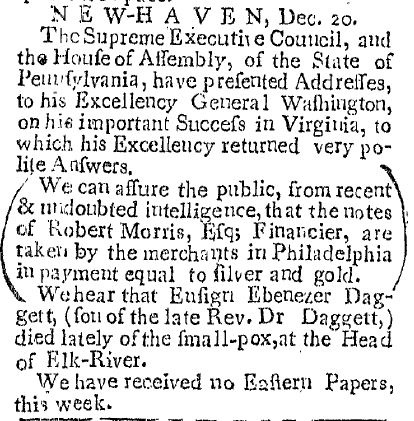
The original "Connecticut Journal" newspaper, December 20, 1781 issue (page 3),
death notice for Ensign Ebenezer Daggett.

Biographic profile of Ensign Ebenezer Daggett, Yale College Class of 1778, from the book
"Yale and her Honor Roll in the American Revolution," 1888. The death date is not accurate, as
Doctor Daniel Shute reported in his journal that Ensign Daggett was still alive on November 24, 1781.
Ensign Daggett was a son of Yale College President and Professor of Divinity Reverend Naphtali
Daggett (1727 - 1780) and brother of First Lieutenant Henry Daggett of the Second Connecticut
Continental Regiment.

Detail of the Manuscript Document "Return of Non Commissioned officers and Soldiers in the Rhode Island Regiment who have been killed in Action or Died in
Hospital Since the 1st of October 1781, together with the Names of the places where Such Died," courtesy of Rhode Island Historical Society Manuscripts
Collection, Providence, Rhode Island, listing the deaths of Privates Newport Greene and Scipio De Woolf at Head of Elk, Maryland.
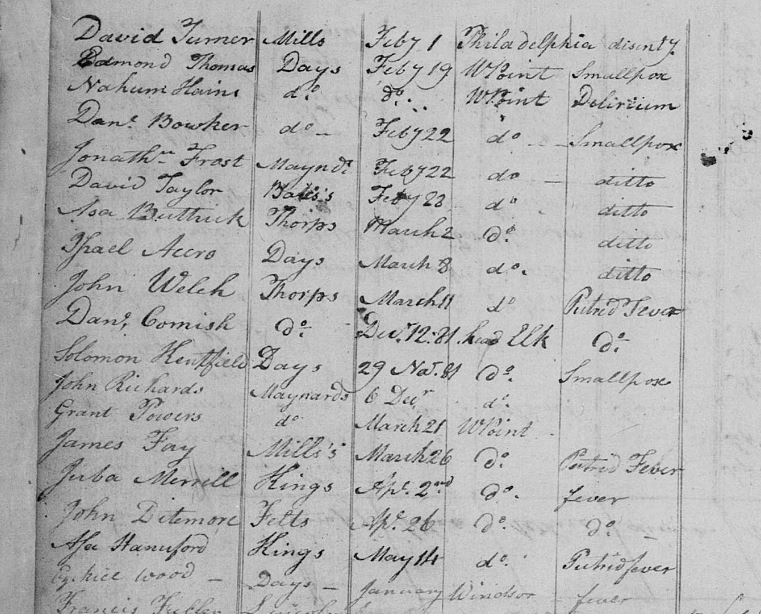
Detail of the Manuscript Document "Register of Noncommissioned Officers and privates in the 7th Massachusetts Regiment
Dead and Discharged since January 1st 1781," courtesy of Massachusetts State Archives, Revolutionary War Rolls, Roll 74,
Regimental Records Book, 7th Massachusetts Continental Regiment. Note Privates Cornish, Kentfield, and Richards.
Some Historic Maps and modern photos of interest from Elkton, Maryland (all landscape photos are copyright of Daniel M. Popek)
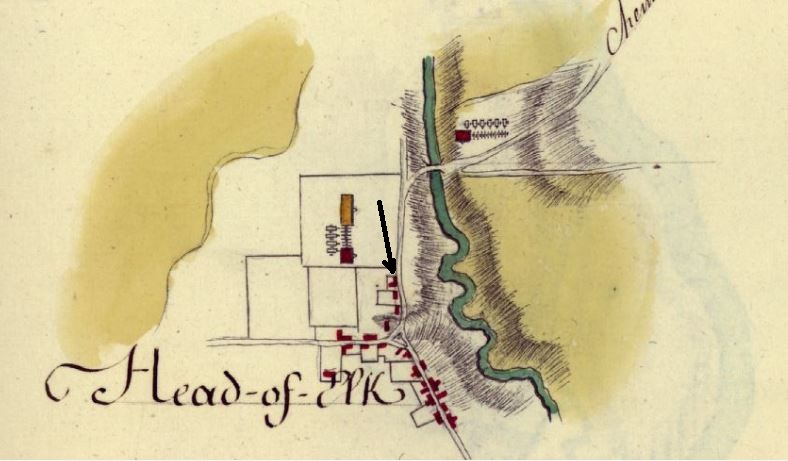
French Army map of Head of Elk in 1782 when the French encamped northwest and northeast
of the village. The black arrow is where I believe the Doctor Abraham Mitchell House
stood in 1781. Map from General Rochambeau Collection, U.S. Library of Congress.

Detail of Elkton from Cecil County Maryland 1858 Map courtesy of U.S. Library of Congress.
The red arrow marks the Doctor Abraham Mitchell House; notice the back area to the north of
the Mitchell House is largely undeveloped.
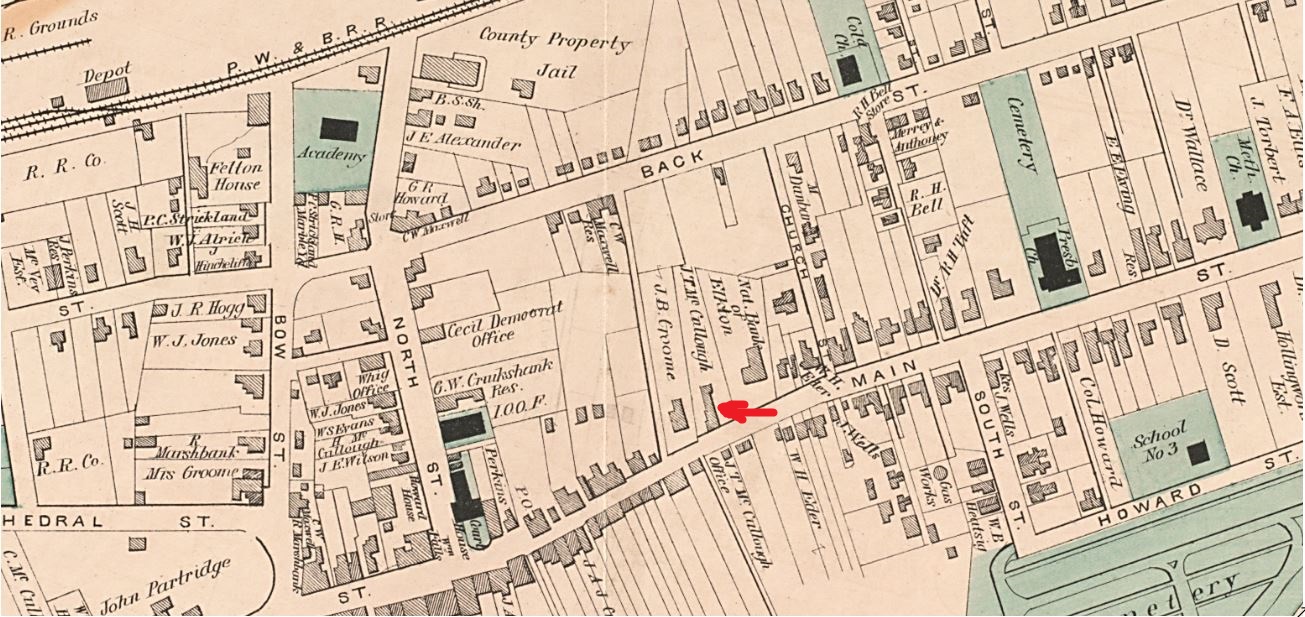
Detail of Elkton from 1877 Elkton, Maryland Map courtesy of U.S. Library of Congress.
The red arrow marks the Doctor Abraham Mitchell House; notice the back area to the north of
the Mitchell House is still largely undeveloped.
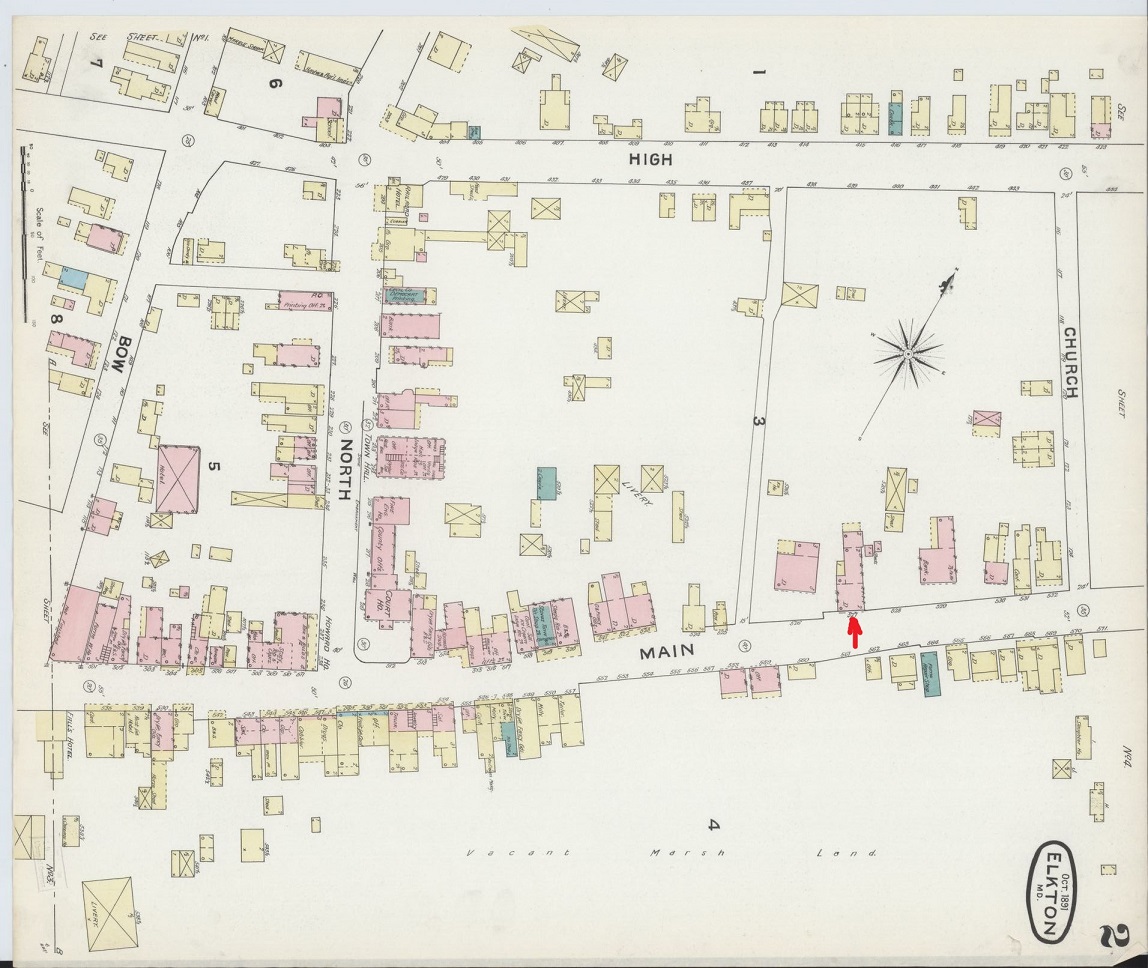
Detail of 1891 Sanborn Insurance Map of Elkton, Maryland courtesy of U.S. Library of Congress.
The red arrow marks the Doctor Abraham Mitchell House; notice the back area to the north of the
Mitchell House is still largely undeveloped.

Detail of 1907 Aerial Map of Elkton, Maryland courtesy of U.S. Library of Congress.
The red arrow marks the Doctor Abraham Mitchell House; notice the back area to the north of the
Mitchell House is still largely undeveloped. None of these houses had deep foundations.
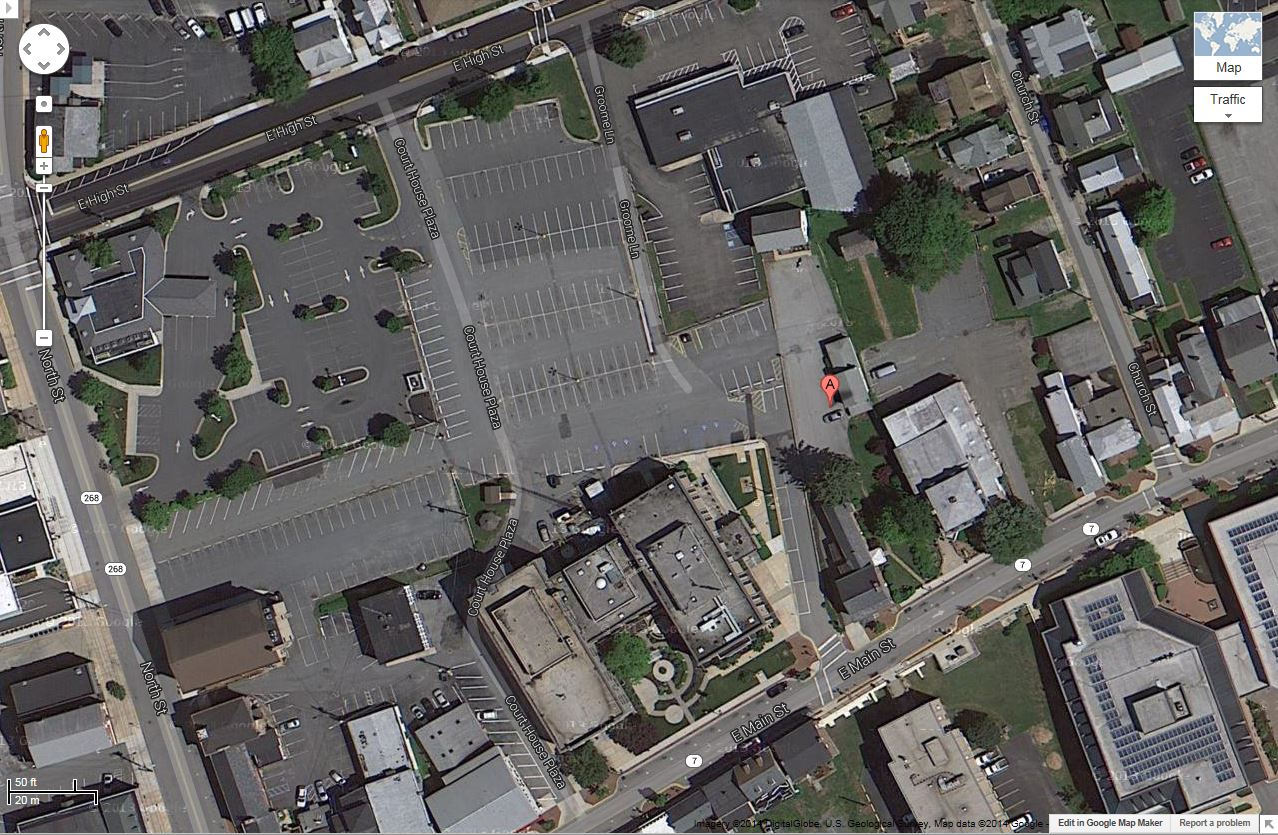
2014 Aerial Photo of the Doctor Abraham Mitchell House in Elkton, Maryland courtesy of Google Maps.
The large building to the left is the Cecil County Courthouse complex that was constructed from 1939 -
1940. Much of the back area has now been paved over, but the pavement appears to be directly on
soil. There are probably some subsurface water, gas, sewer utilities, but most of the electric lines
appear to be above ground. I saw just one deep manhole cover in the pavement behind the Courthouse complex.
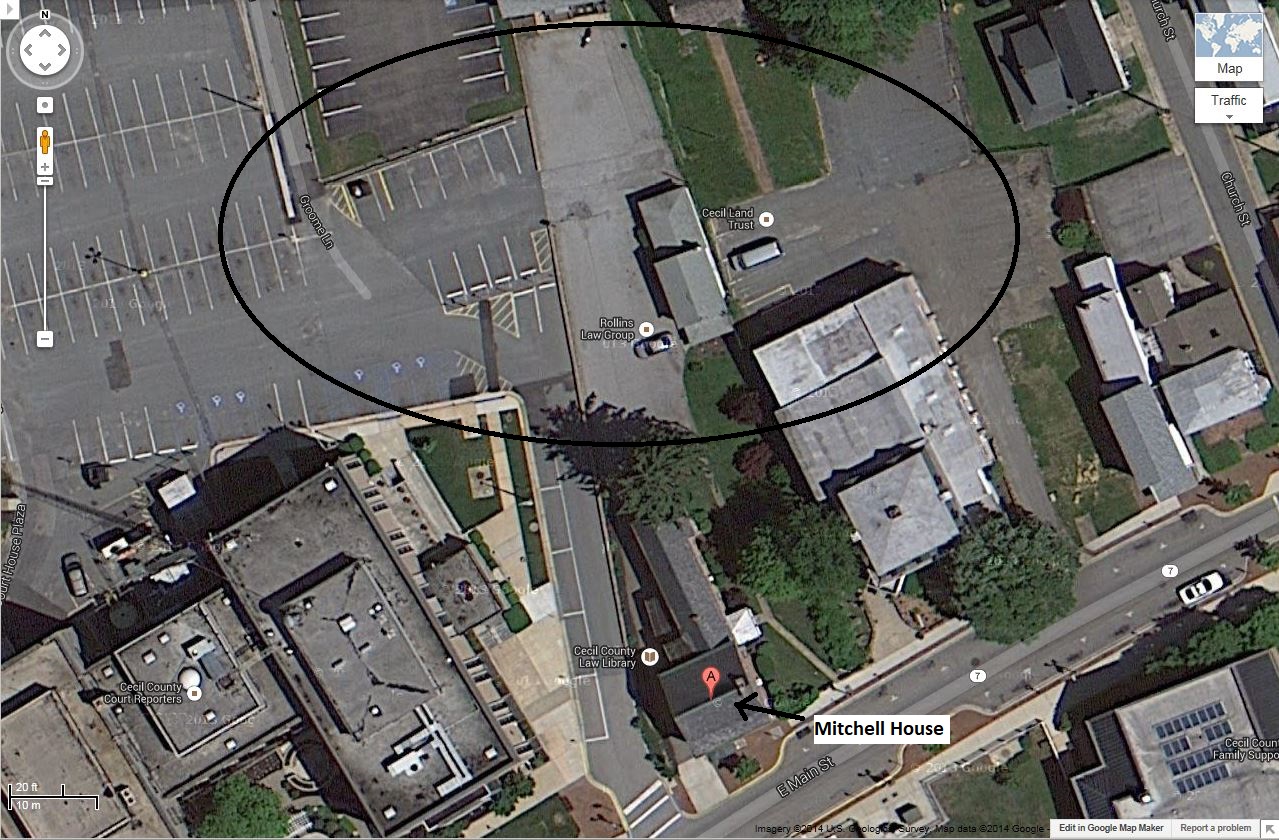
Close up view of 2014 Aerial Photo of the Doctor Abraham Mitchell House in Elkton, Maryland courtesy of
Google Maps. The modern Cecil County Courthouse was constructed in 1939 and has a basement (deep
foundation). The Cecil County Historical Society building to the right was built about 1830 and
also has a basement. I believe the circled area is the likely area where Continental soldiers were
buried who died at the American hospital at the Doctor Abraham Mitchell House. A Ground Penetrating
Radar survey combined with a Cadaver Dog search could potentially identify unmarked graves in the subsurface.

Modern property lines of the current Mitchell House (Number 131) courtesy of Cecil County Government GIS.
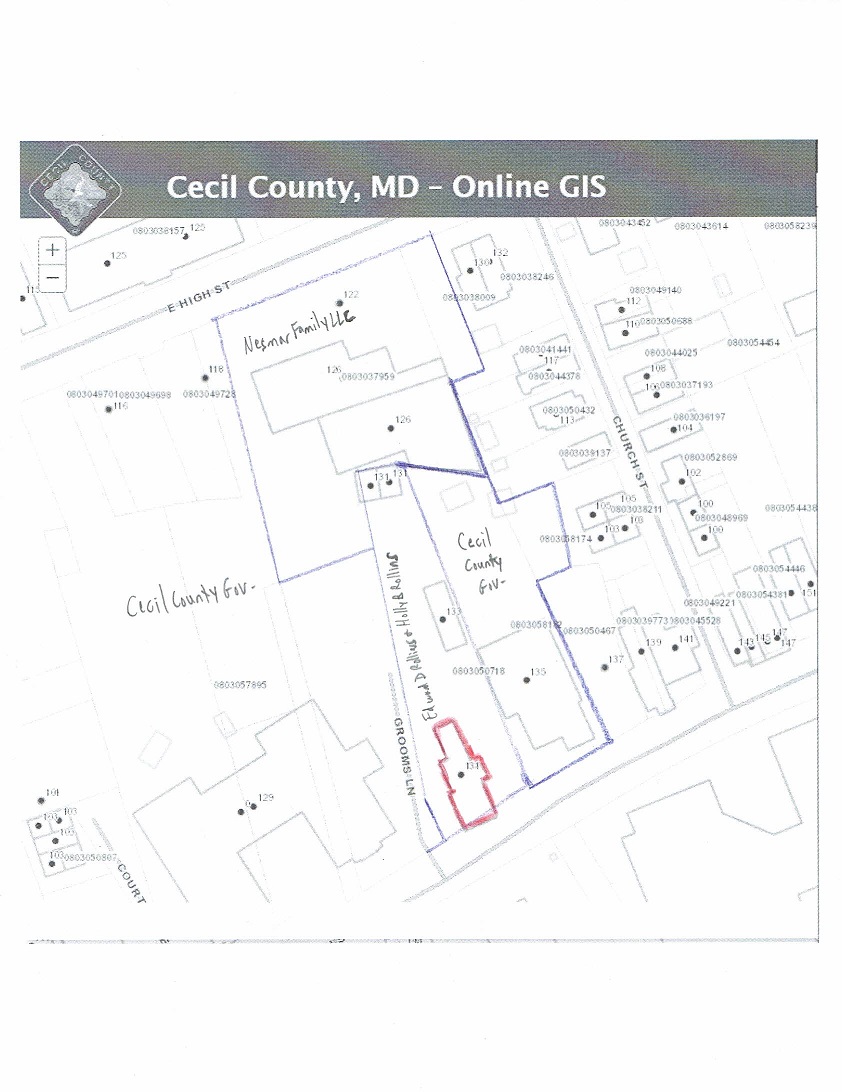
Hand drawn property lines near the current Mitchell House; base map courtesy of Cecil County Government GIS.
The three major property owners in the area are Cecil County Government, Edward and Holly Rollins, who own
the historic Mitchell House, and Nesmar Family LLC.
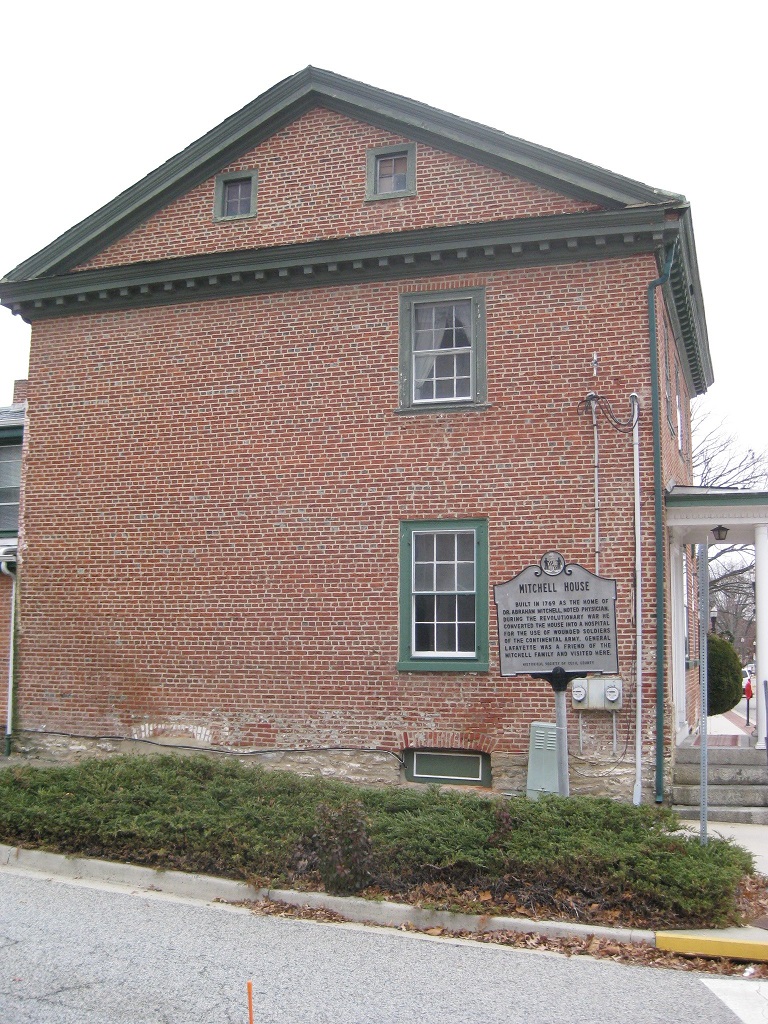
November 29, 2014 view of the historic Doctor Abraham Mitchell House in downtown Elkton, Maryland.
The house is currently owned by the Rollins Family.

November 29, 2014 view of the State of Maryland Historic Sign for the Dr. Abraham Mitchell House.
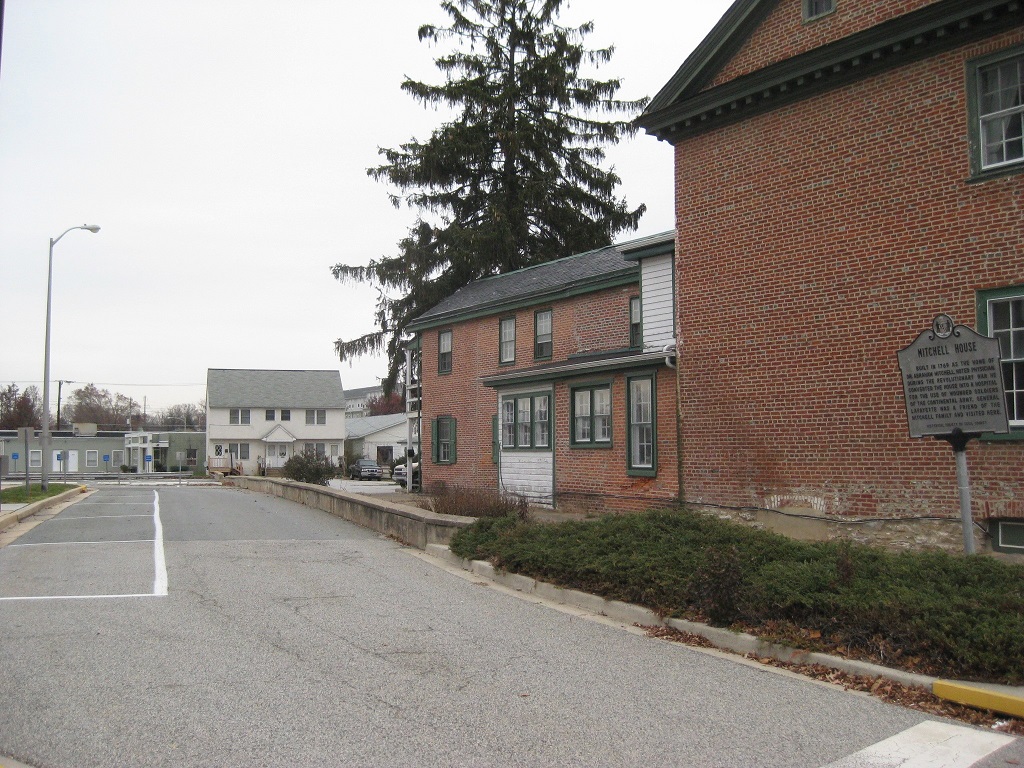
November 29, 2014 view to the north up the alley (Grooms Lane) between the Cecil County Courthouse
to the left and the Doctor Abraham Mitchell House to the right. The house additions in the back of
the Mitchell House were constructed in the early 1800s. The duplex house in the back just to the right
of Grooms Lane appears to have a crawl space, so no deep foundation. The business building (dull green
color) owned by the Nesmar Family behind the duplex house appears to be founded on a concrete slab on
grade (so no deep foundation).
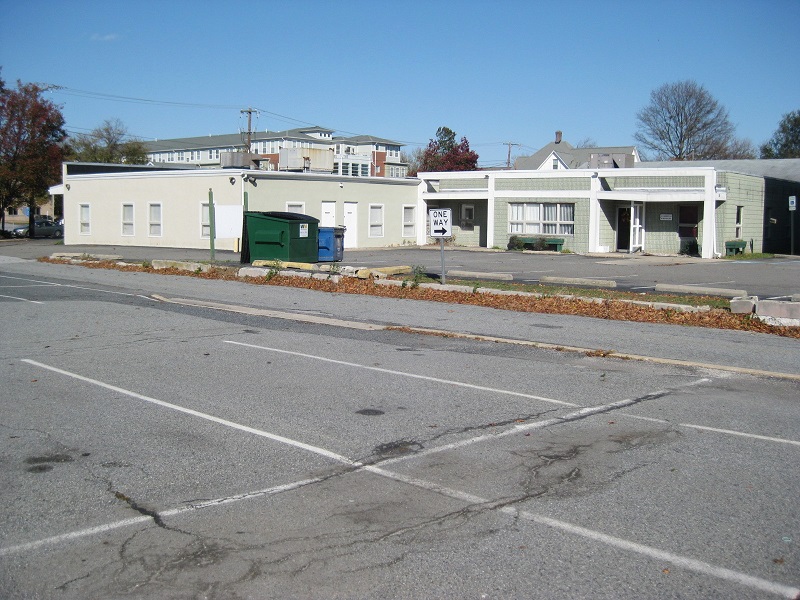
November 10, 2018 view to northeast in the back area of the Courthouse and Doctor Abraham Mitchell
House towards the Nesmar business building. This building does not appear to have a basement.
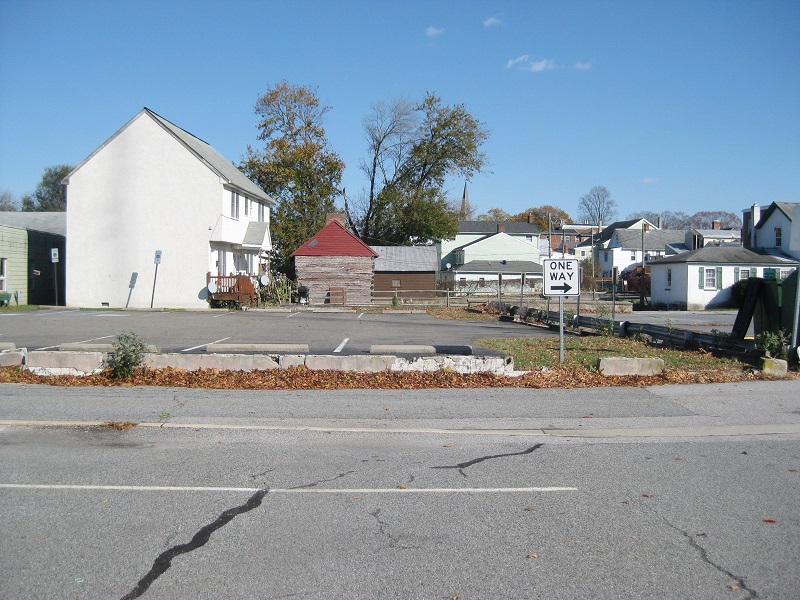
November 10, 2018 view to almost east in the back area of the Courthouse. The white duplex
house appears to be on a crawl space. The small wood loghouse with the red roof area dates
from the late 1700s and was moved here in the 1970s.

November 10, 2018 view panned to the right. Note the mix of pavement and grassy areas.

November 10, 2018 view to the back of the Doctor Abraham Mitchell House, just to the right
of the Stop sign.
The Hollingsworth/Partridge Families Cemetery in Elkton, Removed in 1883
It has been suggested by some local historians, that the Continental soldiers who died from late 1781 to early 1782
were buried in the Hollingsworth/Partridge Families Cemetery which dated from the 1700s. This original Elkton
cemetery was located southwest of modern Bridge Street. The graves in this cemetery were removed to the modern
Elkton Cemetery in 1883, an event reported in the "Cecil Whig" newspaper (see: http://files.usgwarchives.net/md/cecil/cemeteries/hollingsworth.txt).
I do not believe the Continental soldiers were buried in the original Hollingsworth/Partridge Families Cemetery,
which was about one half mile from the Mitchell House hospital. Here are my arguments for a separate soldier cemetery:
1. There were no Revolutionary War military uniform buttons reported in the "Cecil Whig" newspaper articles. American
Continental Army metal uniform military buttons are unique and marked with "USA" and regimental insignia. The Rhode Island
Regiment uniform military buttons are distinctive, stamped with a "RIR," and have been recovered at a few sites, including
the American Continental Army cemetery in Williamsburg, Virginia.
2. Most of the American Continental Army soldiers died of smallpox and/or putrid fever. In 1781, there were strict
quarantine procedures for smallpox to protect the civilian population. Does it seem logical for strange military
soldiers who died of dangerous, infectious diseases to be transported through Head of Elk village a half a mile to
a private family cemetery to be buried? It would have been much easier to bury the soldiers in the back area behind
the Mitchell House.
3. Five of the known American Continental Army soldiers who died were men of color. Does it seem likely that a white,
prominent local family like the Hollingsworths would allow strange African American soldiers from Rhode Island to be buried
in their private family cemetery in 18th century Maryland, a slave state???????????? In fact, a colored soldier from the Rhode
Island Regiment was sent back into slavery in Maryland since he was an escaped slave (in 1777) from a Kent County landowner who
recognized his ex-slave while marching through Head of Elk (see my book for details on Anthony ("Tone") Griffin).
Proposed Cadaver Dog Search and Ground Penetrating Radar Survey
I am proposing a systematic 2D Ground Penetrating Radar Grid Survey be conducted in the back area of the Mitchell House
on a non-event Saturday when there is usually very little traffic after property owner permissions have been secured to try
to locate these suspected Continental Army burials. I would first like to get a Cadaver Dog search in this area after local
property owner permissions have been obtained. Cecil County already owns about half of the target search area, so there is
no reason Cecil County can't begin to search these public areas. Cecil County Government and the Town of Elkton were
informed of the suspected cemetery in August 2019. I need local Cecil County residents and any interested Americans to send
in emails of support for the search to the Cecil County Officials listed below to get the investigation started. Remember,
King Richard III of England was found buried under a parking lot in Leicester, United Kingdom in September 2012 after good
historical research and a Ground Penetrating Radar Survey.
A new technology is 3D Array Ground Penetrating Radar which could be used directly after the Cadaver Dog search instead of
the 2D Ground Penetrating Radar Survey.
Cecil County/Elkton Government Contacts [2025]:
As Cecil County/Elkton, Maryland Government has taken no action to date, We the People
can encourage/motivate our great leaders in Government. Feel free to contact these
public servants that American soldiers who gave their lives to this country shouldn't
be lying buried and forgotten in unmarked graves.
Elkton, Maryland Town Administration: https://www.elkton.org/user/285/contact
This is a web page form email; fill it in and click send.
Cecil County Executive Adam Streight: astreight@cecilcountymd.gov
Cecil County Council Member Dawn Branch: dbranch@cecilcountymd.gov
Cecil County Council Member Bob Meffley: bmeffley@cecilcountymd.gov
Cecil County Council Member Rebecca Hamilton: RHamilton@cecilcountymd.gov
Cecil County Council Member Al Miller: amiller@cecilcountymd.gov
Cecil County Council Member Donna Culberson: dculberson@cecilcountymd.gov
SOURCES
Mrs. Elno A. Carter (editor), "The Journal of Dr. Daniel Shute, Surgeon in the Revolution, 1781-1782,"
New England Historic Genealogical Society Register, 1930, pp. 383 - 389.
Mary Caperton Gillett, Ph.D., "The Army Medical Department 1775 to 1818," U.S. Army Center of Military
History, U.S. Government Printing Office, 1981.
Paul S. Martin, "Geophysics to Cadaver Dogs: Multi-Method Approach to Surveying Historical Cemeteries,"
Geological Society of America Southeastern Section Meeting, Charleston, South Carolina, 2019.
Blair Tormey and Paul S. Martin, "Preserving Historic African American Gravesites in Western
North Carolina Using Ground-Penetrating Radar and Archaeological Human Remains Detection Dogs,"
Geological Society of America Southeastern Section Meeting, Asheville, North Carolina, 2024.
Daniel M. Popek, They "...fought bravely, but were unfortunate...," The True Story of Rhode Island's
"Black Regiment" and the Failure of Segregation in Rhode Island's Continental Line, 1777 - 1783, AuthorHouse, 2015.
[my own book which covers the colored and white soldiers of Rhode Island's Continental Line in a balanced and
accurate account].
John U. Rees, " 'Their presence Here ... Has Saved this State...' Continental Provisional Battalions
with Lafayette in Virginia, 1781, Part 1," The Brigade Dispatch XXXVI, no. 3 (Autumn 2006): 2-23.
John U. Rees, " 'Their presence Here ... Has Saved this State...' Continental Provisional Battalions
with Lafayette in Virginia, 1781, Part 2," The Brigade Dispatch XXXVII, no. 2 (Summer 2007): 2-18.
John U. Rees, " 'Their presence Here ... Has Saved this State...' Continental Provisional Battalions
with Lafayette in Virginia, 1781, Part 3," The Brigade Dispatch XXXVII, no. 4 (Winter 2007): 2-15.
John U. Rees, "Barber's Light Battalion, 1781 (New Jersey Light Company Personnel)" [transcript by John
of manuscript Light Company returns he found in the New Jersey State Archives Revolutionary War Collection].
"Return of Non Commissioned officers and Soldiers in the Rhode Island Regiment who have been killed in
Action or Died in Hospital Since the 1st of October 1781, together with the Names of the places where
Such Died," Manuscript Document, Rhode Island Historical Society Manuscripts Collection, Providence,
Rhode Island.
Connecticut Revolutionary War Rolls, Microfilm, Connecticut State Archives.
Massachusetts Revolutionary War Rolls, Microfilm, Massachusetts State Archives.
U.S. National Archives Microfilm M246, "Revolutionary War Rolls, 1775-1783" (Original Muster Rolls - -
various Continental Army Regiments from 1781 and 1782).
Born in Providence, Rhode Island, Daniel M. Popek is a descendant through his mother's family of a soldier who served
six years in Rhode Island's Continental Line, including the integrated Rhode Island Regiment (Continental) of 1781-1783.
Daniel is an Engineering Geologist/Geotechnical Engineer in North Carolina. He is a member of the Rhode Island Genealogical
Society, and the New England Historic Genealogical Society of Boston, Massachusetts. Daniel is the son of a career Active Duty
U.S. Army Officer (Retired), and the grandson of a U.S. Marine Combat Infantryman of World War II (Third Marine Division).
Daniel has lived in several states in the eastern U.S. during his life including Harford and Frederick Counties in Maryland.
If you have comments or can provide additional information on any historical or archaeological issues,
then please send me (Dan) an email.






